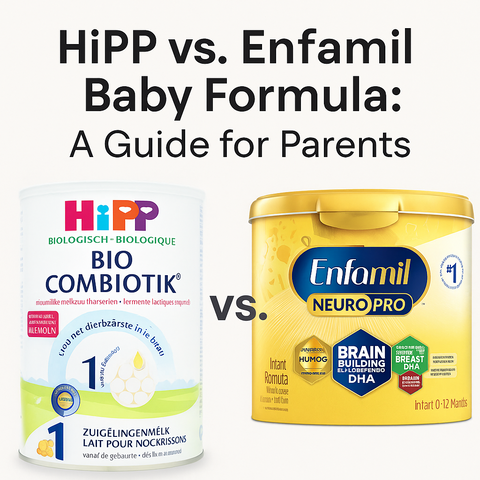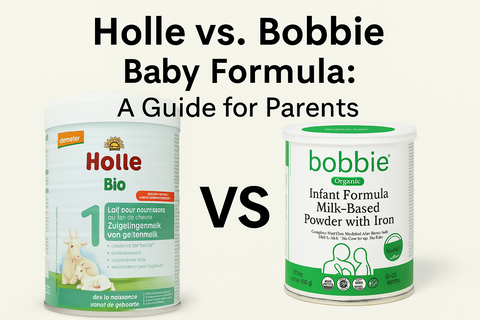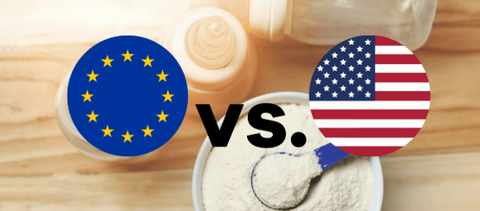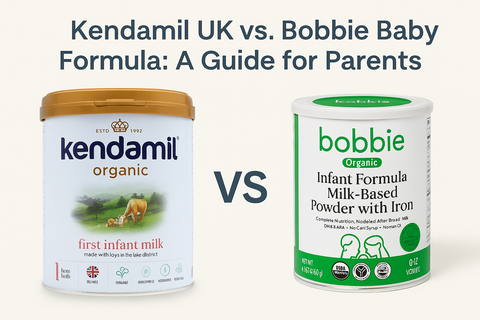Are Seed Oils Safe for Babies? Breaking Down the Science
Dive into the nutritional profile of seed oils—high omega-6 fatty acids, oxidation potential, and lack of omega-3 balance. Compare this to breast milk’s fat composition and the differences between US-made and EU-made formulas, and explore what research says about long-term health impacts on infants.
Picture this: you’re in the kitchen, whipping up a meal for your little one, and you grab a bottle of canola oil. Or maybe you’re scanning formula labels at the store, wondering what’s best for your baby. You’ve heard whispers about seed oils. Are they safe for babies, or should you steer clear? Seed oils like canola, sunflower, and soybean are everywhere, from baby foods to formulas, but their safety for infants is sparking heated debates. In this blog, we’ll dig into the science behind seed oils, compare them to breast milk’s perfect balance, and explore a big divide: US-made vs. EU-made formulas. Let’s break it down so you can feel confident feeding your baby!
What Are Seed Oils?
Seed oils are fats extracted from plant seeds, such as canola, sunflower, corn, and soybean. They’re made through industrial processes like pressing and refining, often with heat and chemicals to squeeze out every last drop. You’ll find them in everyday products, from salad dressings to processed baby foods. In the US, they’re a go-to ingredient in infant formulas like Enfamil or Similac, prized for being cheap and shelf-stable. But here’s the kicker: EU-made formulas, like HiPP or Kendamil, often use them less, favoring whole milk fats or alternatives like coconut oil. Why does this matter? Because what goes into your baby’s tummy shapes their growth, seed oils are raising eyebrows for reasons we’ll explore next.
The Nutritional Profile of Seed Oils
So, what’s in seed oils? They’re loaded with omega-6 fatty acids—think of these as one side of a seesaw. Omega-6s are essential fats, but omega-3s (the other side) are needed to keep things balanced. Seed oils are light on omega-3s, tipping that seesaw way out of whack. Another concern? Oxidation. Seed oils can break down into harmful compounds when heated or stored too long, like how fruit goes bad if left out. For babies, whose tiny bodies are still developing, this imbalance and potential for “bad stuff” has parents and experts asking: are seed oils for babies a wise choice?

Breast Milk: Nature’s Gold Standard
Breast milk is the ultimate blueprint for infant nutrition. Its fats—about 50% saturated, with a mix of omega-3s like DHA and a sprinkle of omega-6—are perfectly tuned for growth. DHA, an omega-3, is a superstar for brain and eye development, while the balanced omega-6 keeps inflammation in check. This harmony supports everything from immunity to tiny tummies. Compare that to seed oils: their sky-high omega-6 and near-zero omega-3s are a far cry from this natural mix. US formulas, packed with soybean or sunflower oil, stray further from breast milk’s ideal. EU formulas, though, often lean on whole milk fats or coconut oil, staying closer to what nature intended.

US-Made vs. EU-Made Formulas: The Seed Oil Divide
Let’s talk formulas. Because not all baby formulas are created equal, especially regarding fats. In the US, big-name brands like Similac and Enfamil lean heavily on seed oils. Think soybean, sunflower, or corn as their go-to fat sources. Why? It’s pretty straightforward: these oils are cheap, easy to get, and have been a staple in the food industry for decades, thanks partly to lobbying from big agriculture. They’re processed to last forever on shelves, which is great for manufacturers but maybe not so much for tiny tummies. Take a peek at a typical US formula label, and you’ll see soybean oil often topping the fat list, pumping up the omega-6 content without much omega-3 to balance it out.
Now, hop across the pond to Europe, and it’s a different story. EU-made formula brands like HiPP, UK-made Kendamil, and Holle take a gentler approach. They dial back on seed oils, mixing whole milk fats or coconut oil to get closer to breast milk’s natural vibe. Why the switch? The EU has some pretty firm rules about what goes into baby food. They’ve set limits on omega-6-heavy oils, banned questionable additives, and even made DHA, a brain-boosting omega-3, mandatory in every formula since 2020. This isn’t just about following rules but crafting a fat balance that feels more like what nature intended for growing babies.
So, what’s the difference in practice? US formulas often end up with a heavier dose of those omega-6-rich seed oils (sometimes 40-50% of the fat content) while EU ones keep it lower, blending in options like whole milk or plant-based fats that don’t tip the scales so hard. For example, Kendamil skips soybean oil entirely, sticking to whole milk from grass-fed cows, while HiPP might use a touch of sunflower oil but pairs it with coconut and rapeseed for a smoother mix. Compare that to Similac, where soybean oil often dominates, and you see the divide. It’s not just about ingredients, it’s about priorities.
The EU’s stricter guidelines don’t stop at fats. They’re all about keeping things clean, leaning into organic ingredients that skip pesticides and synthetic extras. This focus might mean less oxidative stress and a lower chance of inflammation from omega-6 overload, which some experts flag as a concern. Under looser FDA oversight, US formulas don’t have to meet these same standards. The FDA’s more hands-off approach lets companies prioritize cost over tweaking fat profiles, leaving US babies with formulas that stray further from breast milk’s blueprint.
Does this mean US formulas are harmful? Not necessarily, but it’s more about what you’re comfortable with. EU brands aim for a nutritional edge, dodging some of the seed oil quirks that worry parents, like that omega-6/omega-3 imbalance. The result? A choice between convenience and a closer-to-nature approach. Both with their fans, but definitely not the same.

What Does the Research Say?
Science has much to say about seed oils, but direct studies on babies are scarce. High omega-6 diets (which are common with seed oils) can spark inflammation over time, potentially raising risks for obesity, allergies, or even heart issues later in life. One study linked omega-6/omega-3 imbalance to child developmental hiccups, though it wasn’t baby-specific (see this study). With their seed oil heft, US formulas might amplify this concern compared to EU ones, which balance fats better. That said, not everyone’s sold. Some experts argue seed oils are fine in moderation, and no smoking gun proves they harm infants. Still, the lack of omega-3s and oxidation risks keep the debate alive.

Practical Tips for Parents
If you’re formula-feeding, consider EU brands like HiPP or Holle; they’ve got lower seed oil content and more breast milk-like fats. Peek at baby food labels too, as seed oils sneak in everywhere. Not sure what’s best? Chat with your pediatrician for tailored advice.
Conclusion
So, are seed oils safe for babies? Their high omega-6, low omega-3 vibe and oxidation risks don’t match breast milk’s gold standard. US formulas lean hard into seed oils, while EU ones play it safer with stricter rules and better balance. Research isn’t definitive, but it’s enough to make you think twice. You’ve got the power to choose what feels right, whether it’s an EU formula or a seed-oil-free kitchen. Feed your baby with confidence! Have you tried EU formulas for your little one?
Let Us Help You Choose
Need assistance selecting the perfect vegetarian formula for your baby? Our team is ready to guide you through the options to meet your family’s needs. Please shoot us an email at support@organicformulashop.com or check our baby formula comparison chart to help you understand the differences between the formulas we offer.
Disclaimer: This blog is for informational purposes and isn’t medical advice. Every baby’s needs are unique, so please consult your pediatrician or a healthcare professional before changing your little one’s diet or formula.




